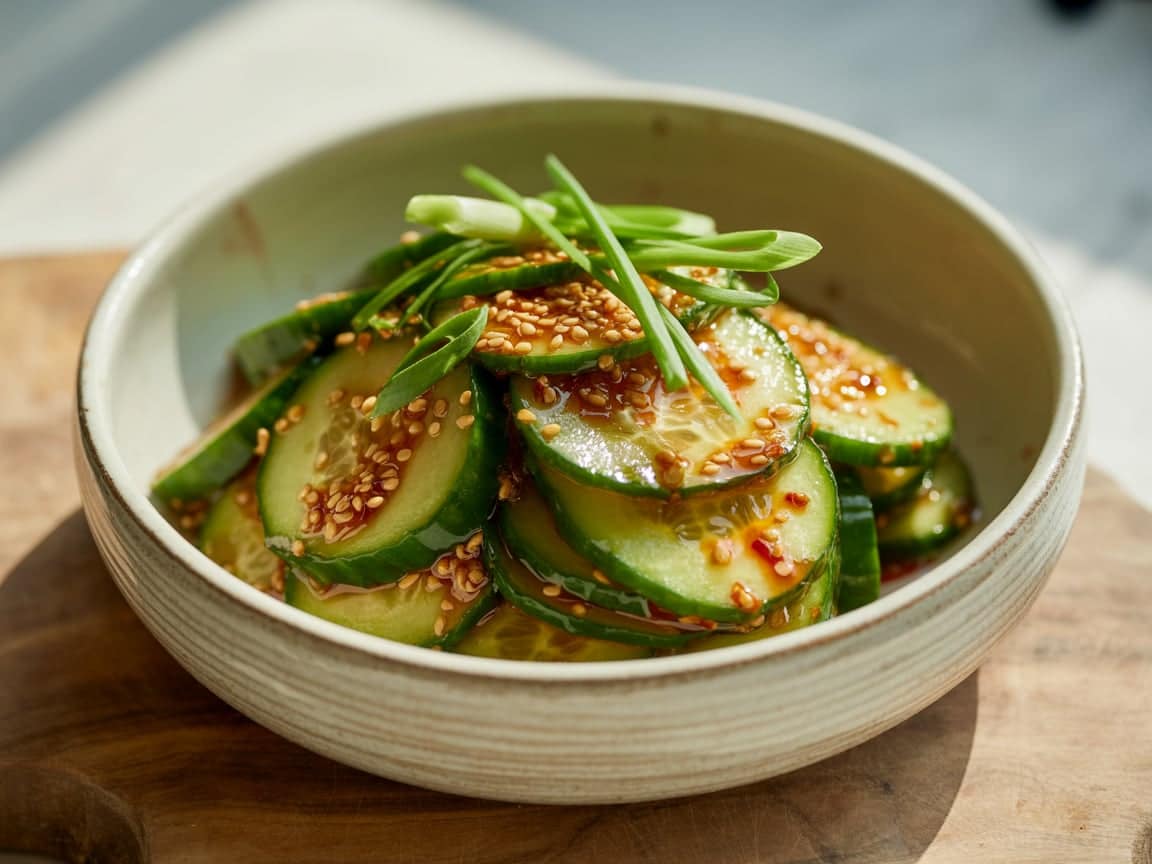Ahi Tuna Tartare isn’t just a fancy appetizer you order at upscale restaurants—it’s a bold yet approachable dish you can create in your own cozy kitchen. At Cozy Bites Recipes, founder Sarah brings you comforting meals rooted in warmth and family tradition. While her passion for hearty one-pot dinners and delightful desserts began in her grandmother’s kitchen, her culinary journey has grown to embrace the elegant simplicity of dishes like tuna tartare—meals that spark connection, creativity, and joy.
Sarah believes that food is about more than nourishment; it’s a way to gather, smile, and turn everyday moments into something truly special. That belief shines in recipes that are both simple and sophisticated—like this one. Whether you’re new to raw dishes or simply craving something light, protein-rich, and full of flavor, this guide to Ahi Tuna Tartare will walk you through everything from its origins to how to master it at home.
Looking for inspiration? Try this high-protein sushi bake for another bold seafood option your whole family will love.
Table of Contents
What is Ahi Tuna Tartare?
Understanding the Origins of Tuna Tartare
Tartare, traditionally a preparation of finely chopped raw meat or fish, finds its roots in French cuisine. It was originally served as steak tartare, but over time, variations emerged—especially in coastal regions where seafood took center stage. Enter tuna tartare—a modern twist inspired by Japanese sashimi and Hawaiian poke that blends clean flavors with global influence.
Today, tuna tartare is celebrated for its minimalist sophistication. Unlike ceviche, which uses acid to “cook” the fish, tartare leaves the tuna raw, allowing its natural buttery texture and clean flavor to shine through.
How Ahi Tuna Differs from Other Tuna Types
So, what makes Ahi Tuna Tartare different from generic tuna tartare? The answer lies in the fish itself.
“Ahi” is the Hawaiian name for yellowfin or bigeye tuna. Compared to skipjack or albacore, Ahi offers a firmer texture and a deeper red color—perfect for raw preparations. Its flavor is subtly sweet and not overly fishy, which makes it ideal for tartare where balance is key.
The richness of Ahi tuna pairs beautifully with bold but simple ingredients like soy sauce, avocado, and sesame oil—allowing the quality of the fish to truly shine.
Don’t miss our calamari dipping sauce—it complements seafood dishes like tartare when served as a creative starter spread.
Key Ingredients in Ahi Tuna Tartare
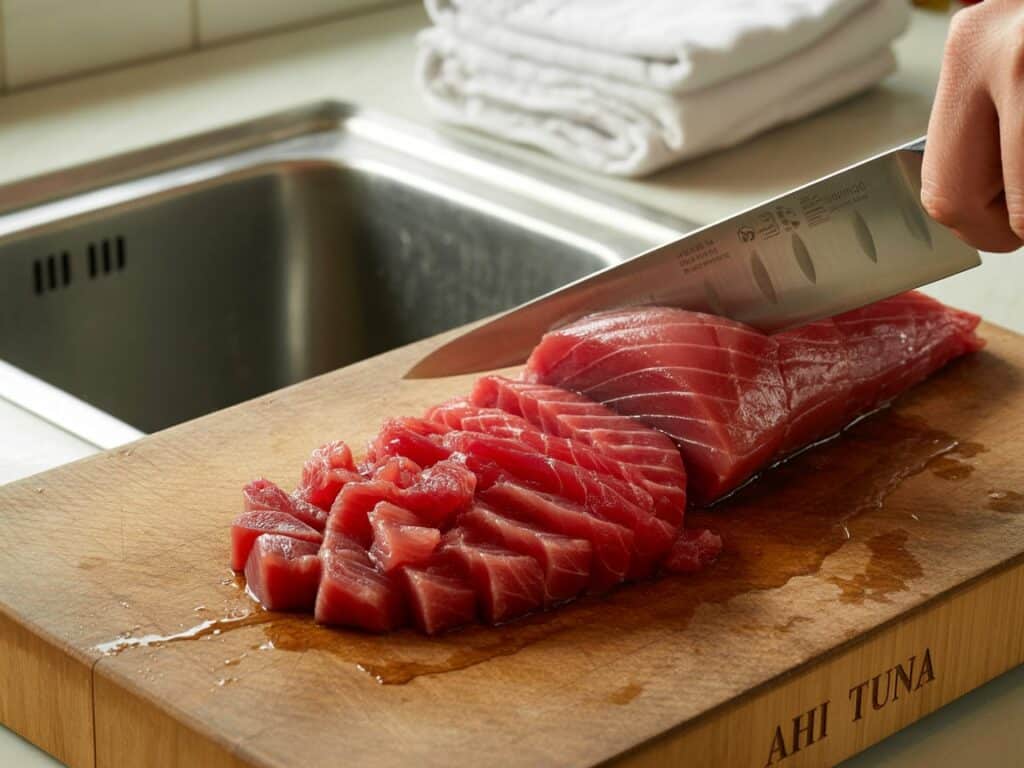
Fresh Ahi Tuna: What to Look For and Where to Buy It
The most important component of a delicious Ahi Tuna Tartare is, of course, the tuna. But not just any tuna will do. To safely and confidently enjoy raw tuna at home, you need to source sushi-grade or sashimi-grade Ahi tuna. These labels indicate that the fish has been handled and frozen according to strict FDA guidelines to minimize the risk of parasites.
Here’s what to look for:
| Feature | Description |
|---|---|
| Color | Bright, ruby-red flesh with minimal browning |
| Texture | Firm and moist, not mushy or watery |
| Smell | Fresh, ocean-like scent (not “fishy”) |
| Cut | Ask for center-cut loin for best uniform dicing |
Where to buy it:
- Local fish markets or high-end grocery stores
- Online seafood retailers like Honolulu Fish Co. or Fulton Fish Market
- Some Whole Foods or specialty grocers
Always ask your fishmonger for confirmation that the tuna is suitable for raw consumption. If in doubt, don’t risk it—quality is everything in tartare.
Essential Flavor Builders: Soy Sauce, Sesame Oil, and More
While the tuna does the heavy lifting in terms of flavor, the ingredients you use to season and complement it are just as important. A proper tartare balances umami, acidity, freshness, and texture. Here are some core components found in most Ahi Tuna Tartare recipes:
| Ingredient | Purpose in Tartare |
|---|---|
| Soy Sauce | Adds deep umami and saltiness |
| Sesame Oil | Offers nutty richness and aroma |
| Lime or Lemon Juice | Brightens the dish with a touch of acidity |
| Avocado | Creamy contrast to the tuna’s firmness |
| Green Onion/Chives | Adds mild sharpness and freshness |
| Cucumber or Jalapeño | Crunch or mild heat depending on preference |
| Ginger or Wasabi | Layers in a little heat and zing |
| Microgreens or Herbs | Finish the dish with a fresh, gourmet touch |
Optional garnishes like tobiko (flying fish roe), sesame seeds, or seaweed flakes can elevate your tartare from casual to showstopper.
For a delicious dressing idea to complement tartare, check out our refreshing honey ginger dressing.
Is Ahi Tuna Tartare Safe to Eat Raw?
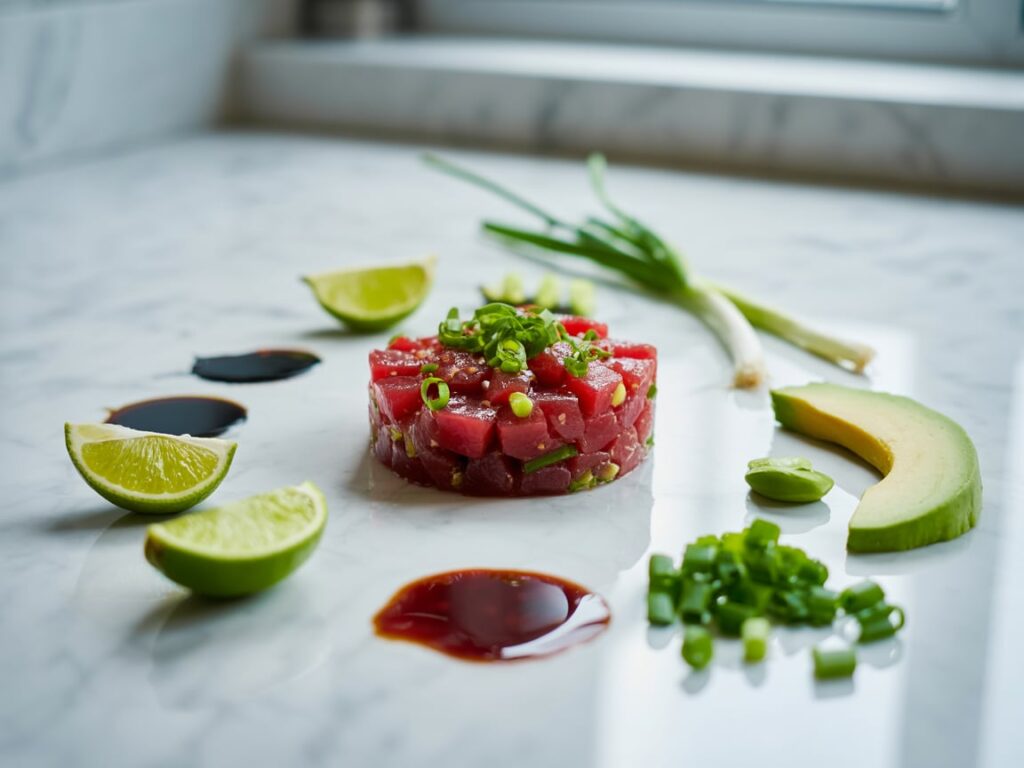
Can You Eat Ahi Tuna Raw? Food Safety Guidelines
Yes, you can absolutely eat Ahi tuna raw—but only if it’s been properly handled and labeled as safe for raw consumption. That means purchasing sushi-grade Ahi tuna that has been flash-frozen at -4°F (-20°C) for at least seven days, as required by FDA standards. This process kills parasites that could be present in wild fish.
To keep things safe when preparing Ahi Tuna Tartare at home, follow these essential tips:
- Buy from reputable suppliers: Stick to trusted markets or online vendors specializing in raw seafood.
- Keep it cold: Store the tuna in the coldest part of your fridge and use it within 24 hours.
- Use clean tools: Sanitize your knives, cutting boards, and hands to avoid cross-contamination.
- Prepare just before serving: Raw fish is best when freshly prepared and consumed.
If you’re pregnant, immunocompromised, or serving the dish to young children, it’s best to consult a healthcare professional before consuming raw fish.
Sushi-Grade vs. Sashimi-Grade: What’s the Difference?
While the terms sushi-grade and sashimi-grade are commonly used interchangeably in the U.S., they aren’t governed by strict legal definitions. However, they signal to consumers that the tuna is safe for raw consumption.
| Label | What It Implies |
|---|---|
| Sushi-Grade | The highest-quality tuna, frozen to FDA guidelines |
| Sashimi-Grade | Also suitable for raw consumption, equally safe |
The label is only as reliable as the vendor you purchase from, so always do your research.
Looking for a delicious seafood-meets-salad option? Don’t miss our steak chimichurri dense bean salad recipe—a bold pairing that shares the same flavor-forward philosophy as tartare.
How to Make Ahi Tuna Tartare at Home
Step-by-Step Preparation Instructions: Ahi Tuna Tartare Recipe
Making Ahi Tuna Tartare at home may sound like a task best left to chefs in starched whites, but it’s surprisingly simple—especially when you start with great ingredients and a little know-how. Follow this step-by-step process to create a fresh, flavorful tartare that’ll wow your guests or elevate a quiet night in.
Prep Time: 15 minutes
Servings: 2 (as appetizer)
No cooking required
Ingredients:
- 6 oz sushi-grade Ahi tuna, diced into small cubes
- 1 tablespoon soy sauce (low-sodium preferred)
- 1 teaspoon sesame oil
- 1 teaspoon lime juice (freshly squeezed)
- 1 teaspoon rice vinegar
- 1 teaspoon finely grated fresh ginger
- 1 tablespoon finely chopped green onion
- ½ avocado, diced
- Salt and pepper to taste
- Optional: sesame seeds, microgreens, wasabi, sriracha
Instructions:
- Dice the tuna into ¼-inch cubes using a very sharp knife. Work quickly and return to fridge.
- In a mixing bowl, whisk together soy sauce, sesame oil, lime juice, rice vinegar, and grated ginger.
- Gently fold in the tuna cubes and stir until coated.
- Add the green onions and avocado, stirring just to combine. Taste and season with salt and pepper as needed.
- Serve immediately over cucumber rounds, crispy wontons, or molded into a ring with microgreens on top.
Pro Tip: Chill your serving plates before plating for a more elevated presentation.
Want to explore something equally creative but warm and hearty? Discover great ideas like our Japanese Mounjaro recipe—a cozy twist rooted in flavor-forward balance.
Tools and Techniques for Perfect Texture
To get that signature texture that melts in your mouth but holds together beautifully on a plate, you’ll need:
- A sushi knife or razor-sharp chef’s knife: This prevents tearing the delicate tuna flesh.
- Glass or stainless steel mixing bowls: Avoid reactive metals that can alter flavor.
- A ring mold (optional): For elegant plating in neat rounds.
- Cold prep environment: Keep ingredients chilled from start to finish.
Texture is everything in a tartare. You want your tuna firm but tender, the avocado just ripe enough to add creaminess, and your additions to complement, not compete.
Looking for a refreshing pairing? Don’t miss our Arizona watermelon fruit juice—its bright, sweet flavors play beautifully against the umami of tartare.
Print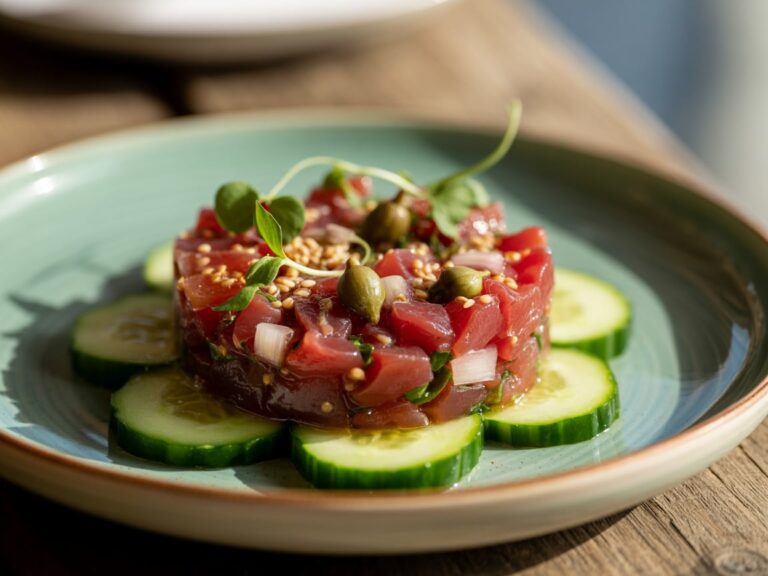
Ahi Tuna Tartare Recipe
Learn to prepare Ahi Tuna Tartare like a pro—safe sourcing, ingredient pairings, serving styles, and nutrition tips inside this 2500+ word guide.
- Total Time: 30 minutes
- Yield: 2 appetizer servings 1x
Ingredients
- 6 oz sushi-grade Ahi tuna, diced into small cubes
- 1 tablespoon soy sauce (low-sodium preferred)
- 1 teaspoon sesame oil
- 1 teaspoon lime juice (freshly squeezed)
- 1 teaspoon rice vinegar
- 1 teaspoon finely grated fresh ginger
- 1 tablespoon finely chopped green onion
- ½ avocado, diced
- Salt and pepper to taste
- Optional: sesame seeds, microgreens, wasabi, sriracha
Instructions
- Dice the tuna into ¼-inch cubes using a very sharp knife. Work quickly and return to fridge.
- In a mixing bowl, whisk together soy sauce, sesame oil, lime juice, rice vinegar, and grated ginger.
- Gently fold in the tuna cubes and stir until coated.
- Add the green onions and avocado, stirring just to combine. Taste and season with salt and pepper as needed.
- Serve immediately over cucumber rounds, crispy wontons, or molded into a ring with microgreens on top.
Notes
Pro Tip: Chill your serving plates before plating for a more elevated presentation.
- Prep Time: 15 minutes
- Cook Time: 15 minutes
Nutrition
- Serving Size: 2 appetizer servings
Ahi Tuna Tartare Variations and Fusion Flavors
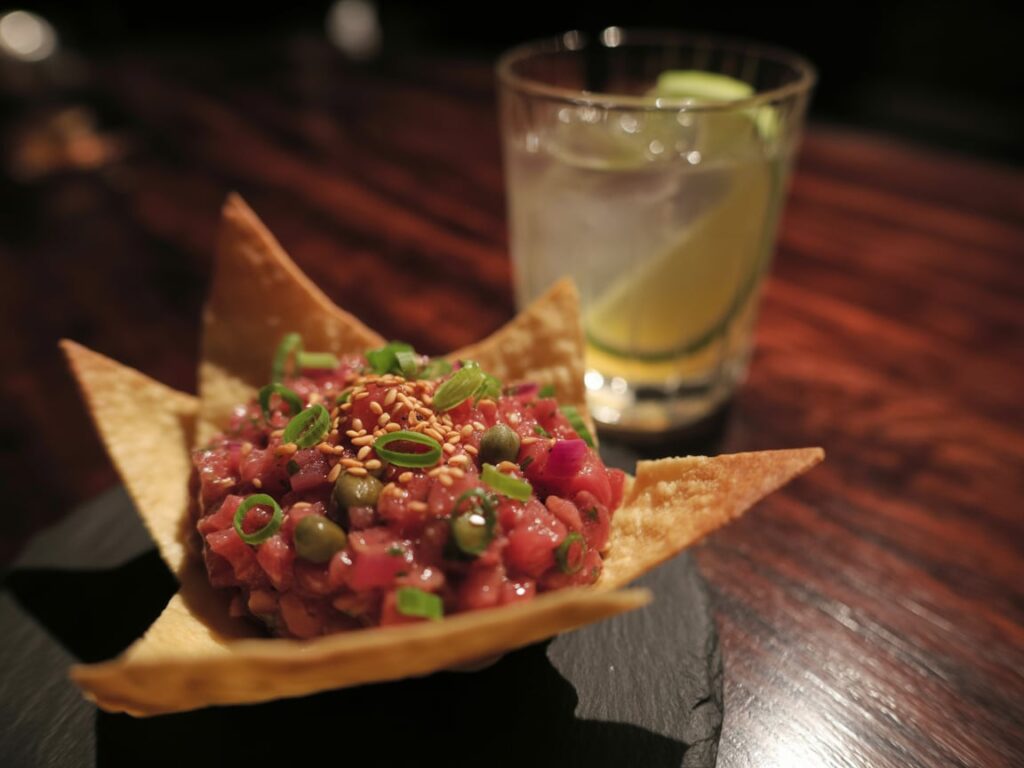
Spicy Ahi Tuna Tartare with Sriracha and Avocado
If you enjoy a little heat, Spicy Ahi Tuna Tartare is where it’s at. This variation adds a fiery kick that beautifully contrasts the cool, buttery texture of the tuna. It’s a favorite among sushi lovers and spicy food fans alike.
How to Make It:
- Start with your base tartare mixture.
- Mix in 1–2 teaspoons of sriracha (or your favorite hot chili sauce).
- Add ½ teaspoon of wasabi paste for a sharper burn.
- Toss in diced avocado for a creamy balance.
- Finish with a sprinkle of black sesame seeds and thinly sliced jalapeño.
The result? A punchy, Instagram-worthy appetizer that pairs well with chilled sake or a citrus-forward IPA.
This style works great as a topping for crispy wonton chips, or even spooned into mini taco shells for a bold party bite.
Asian-Inspired, Mediterranean, and Tropical Versions
One of the best things about Ahi Tuna Tartare is its versatility. Whether you’re craving East Asian umami, Mediterranean freshness, or tropical sweetness, there’s a variation to match your mood—and your menu.
Asian-Inspired Twist
- Add: Pickled ginger, ponzu sauce, toasted nori strips
- Garnish with: daikon sprouts or microgreens
Mediterranean Style
- Swap soy sauce for: extra virgin olive oil + lemon juice
- Mix in: capers, chopped kalamata olives, sun-dried tomatoes
- Finish with: fresh parsley and a hint of garlic
Tropical Fusion
- Toss tuna with: mango cubes, coconut aminos, and lime zest
- Add: diced red bell pepper and cilantro
- Serve on: pineapple slices or plantain chips
Each flavor profile brings something new to the table—whether it’s the briny punch of capers or the sunny sweetness of mango.
Don’t miss our high-protein dense bean salad for another fusion-friendly recipe that balances freshness and depth.
How to Serve Ahi Tuna Tartare
Best Serving Styles: Appetizer Cups, Crispy Wontons, or Cucumber Rounds
Presentation is everything when it comes to Ahi Tuna Tartare. It’s a dish that instantly elevates any gathering, but it doesn’t have to be complicated. Whether you’re hosting a dinner party or simply treating yourself, here are a few creative and simple serving styles:
| Serving Style | Description |
|---|---|
| Crispy Wonton Chips | Lightly fried wonton wrappers for a crunchy base |
| Cucumber Rounds | Thin, chilled slices add freshness and visual appeal |
| Mini Appetizer Cups | Great for individual servings at parties |
| Avocado Halves | Serve tartare right inside an avocado for a wow factor |
| Tartare Towers | Use a ring mold to stack tuna, avocado, and mango neatly |
| Endive Spears | Perfect for low-carb guests with a crisp bite |
For best results, always serve tartare chilled. A pre-cooled plate or slate board can keep the dish refreshing and visually polished.
Looking for inspiration? Try our breve latte alongside a weekend brunch tartare for a surprising pairing that works beautifully.
Pairing Suggestions: Wine, Cocktails, and Sides
What you serve with your Ahi Tuna Tartare can take it from great to unforgettable. Because this dish is so clean and flavor-forward, your pairings should enhance, not overpower.
Drink Pairings
| Drink | Why It Works |
|---|---|
| Dry Riesling | Crisp, citrusy, and complements the tuna’s richness |
| Sauvignon Blanc | Herbal and refreshing, great with avocado and lime |
| Sake or Soju | Traditional pairing that enhances umami notes |
| Ginger Mojito | A bright, minty cocktail to lift the palate |
Side Ideas
- Light seaweed salad
- Pickled vegetables or ginger
- A simple cabbage slaw with sesame vinaigrette
- Cold soba noodles dressed in ponzu
Keep everything cold, light, and balanced for a meal that feels refined but satisfying.
Don’t miss our honey peach cream cheese cupcakes for a sweet finish that brings harmony to your tartare experience.
Nutritional Benefits of Ahi Tuna Tartare
Low-Calorie, High-Protein, and Omega-3 Packed
Beyond its sophisticated taste and elegant presentation, Ahi Tuna Tartare is a nutritional powerhouse. It’s low in calories, rich in lean protein, and full of beneficial fats—making it a guilt-free indulgence that fits right into a clean-eating lifestyle.
Here’s a typical breakdown per 3 oz serving (without heavy sauces or extras):
| Nutrient | Amount |
|---|---|
| Calories | ~120 kcal |
| Protein | ~22 grams |
| Fat | ~3 grams |
| Carbs | ~1 gram |
| Omega-3s | ~900–1,200 mg |
The high omega-3 fatty acid content supports heart health, brain function, and anti-inflammatory benefits. Its low carb profile makes it a perfect option for those following keto, paleo, or low-sugar diets.
Plus, because tartare is served raw, none of the heat-sensitive nutrients are lost during cooking.
Pairing tartare with avocado further boosts its fiber and healthy fat profile—making it as nourishing as it is satisfying.
A Keto and Paleo Friendly Appetizer Option
For anyone following a low-carb or high-protein lifestyle, Ahi Tuna Tartare is a dream dish. It skips processed ingredients and leans into whole, clean components:
- No added sugars
- Gluten-free (when using tamari or coconut aminos)
- Zero grains or fillers
- Full of satisfying fats and lean protein
Want more nourishing, clean recipes? Discover great ideas like our chia seeds smoothie that align with your wellness goals while keeping things tasty and simple.
And because it’s so customizable, tartare can be made dairy-free, soy-free, or spicy, depending on dietary needs—without sacrificing flavor.
Common Mistakes to Avoid When Making Ahi Tuna Tartare
Using Low-Quality Tuna or Improper Storage
The number one mistake home cooks make when preparing Ahi Tuna Tartare? Skimping on the tuna quality. Because tartare is a raw dish, freshness is everything. Using non-sushi-grade or improperly stored tuna puts both the flavor and your health at risk.
Here’s how to avoid common sourcing and storage errors:
| Mistake | Fix It With This Tip |
|---|---|
| Buying non-sushi-grade tuna | Always ask if it’s safe for raw consumption |
| Letting tuna sit too long | Prepare and serve immediately—within 24 hrs max |
| Storing tuna improperly | Keep at the coldest part of your fridge (below 40°F) |
| Exposing tuna to air | Wrap tightly and refrigerate right away |
If you wouldn’t eat it raw at a sushi bar, don’t use it for tartare at home. The rule is simple: the fresher, the better.
Overpowering the Tuna with Too Many Flavors
Another common issue? Over-seasoning. It’s easy to go overboard with soy sauce, citrus, garlic, or spicy elements like wasabi and sriracha. But when it comes to tartare, less is more.
Tuna has a subtle, buttery flavor that should always be the star of the plate. Here’s how to let it shine:
- Stick to 2–3 flavor-enhancers: soy, sesame oil, lime juice
- Use acids sparingly: Too much lime can “cook” the tuna like ceviche
- Avoid strong raw onions: Go for chives or scallions for a milder touch
- Skip mayo-based sauces: These can mask the tuna’s clean taste
Even your add-ins—like avocado, cucumber, or mango—should complement, not compete.
Want to explore another elegant seafood flavor combo? Don’t miss our vibrant cranberry pomegranate juice—a refreshing sipper that works well with tartare during brunch or summer dinners.
Ahi Tuna Tartare FAQs
What is tuna tartare made of?
Tuna tartare is made from sushi-grade raw tuna, usually Ahi or yellowfin, that’s finely diced and mixed with flavorful ingredients like soy sauce, sesame oil, lime juice, ginger, and green onions. Many versions also include avocado, chili, or fresh herbs for added texture and taste. The goal is to highlight the tuna’s natural flavor while adding layers of umami and freshness.
Is tuna tartare completely raw?
Yes, tuna tartare is completely raw. It’s not cooked by heat or acid, unlike ceviche. That’s why it’s critical to use sushi-grade Ahi tuna, which has been frozen according to FDA guidelines to eliminate parasites. The dish is served chilled and should be eaten fresh—ideally within an hour of preparation.
Can Ahi tuna be eaten raw?
Absolutely. In fact, Ahi tuna is one of the most popular types of tuna served raw in dishes like sushi, sashimi, poke, and tartare. Just make sure it’s labeled sushi-grade or sashimi-grade and purchased from a trusted source. Ahi’s firm texture and mild flavor make it ideal for raw preparations.
What does tuna tartare taste like?
Tuna tartare has a buttery, clean, and mildly sweet flavor, with a smooth, silky texture. The seasoning ingredients—like soy, citrus, sesame, and herbs—add brightness and depth without overpowering the fish. If avocado is included, expect a creamy finish. It’s luxurious, refreshing, and perfectly balanced.
How long does tuna tartare last in the fridge?
Tuna tartare is best consumed immediately after preparation, but if needed, it can be stored in an airtight container in the fridge for up to 24 hours. However, texture and taste will decline quickly, and food safety becomes a concern beyond that point. For the best experience, make it fresh.
Can I prepare Ahi Tuna Tartare in advance?
You can prep some components (like chopping ingredients or mixing the sauce) in advance, but do not mix the raw tuna with the other ingredients until just before serving. This keeps the texture firm and prevents the acid from breaking down the fish. Always keep the tuna refrigerated until you’re ready to serve.
Conclusion: Ahi Tuna Tartare
Whether you’re hosting a stylish dinner party or simply craving something elegant and healthy, Ahi Tuna Tartare is the kind of dish that delivers both flavor and finesse with minimal effort. By choosing high-quality sushi-grade tuna, balancing bold flavors with care, and serving it with flair, you can turn your kitchen into a gourmet experience.
At Cozy Bites Recipes, every dish—whether rustic or refined—is crafted to bring people together around good food and warm conversation. And just like Sarah’s memories from her grandmother’s kitchen, tartare is about more than ingredients. It’s about sharing a moment, a bite, a story.
Looking for more bold but approachable dishes?
Check out our natural Zepbound recipe or natural Mounjaro recipe—both offer flavor-forward, wellness-friendly recipes that bring comfort and style to the table.



